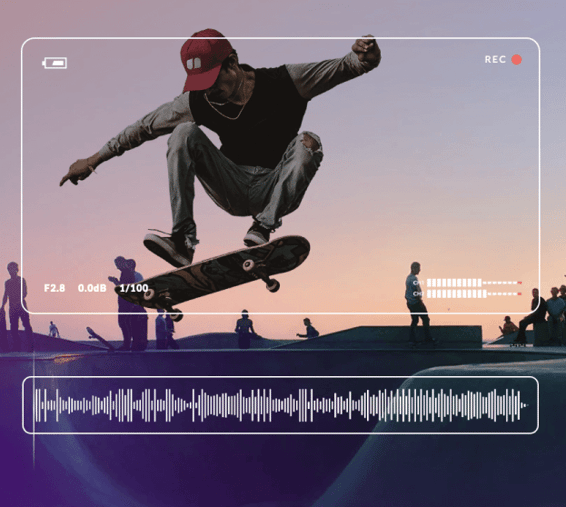Welcome to the Best
Royalty Free Music Library






Check Out Our Music Library
We know the right song can make or break your project. That’s why every track in our library is vetted by award-winning producers. Hear for yourself. We've curated a playlist from our music library.
Looking for something different?
We got you. From classical to hip hop to indie, our audio library contains thousands of outstanding tracks. Use one of our 13 filters or check out other curated playlists to find what you need in minutes.
BROWSE THE FULL CATALOG
Dead Simple Licensing
Never worry about sync licensing again. With Soundstripe, your membership covers the cost for every song license. Just find the right track, download the file, and get a custom license. That’s it. No channel or media-specific fees, no recurring royalties, ever. Here’s more good news: you have unlimited licenses. Go ahead, download as many songs as you want.
Finding the Right Royalty Free Music Library
The production process waits for no one, or so it often seems.
As soon as you wrap one project — a wedding video, short film, commercial, etc. — the time has already come to fine-tune the budget, shot list, and music selection for the next project.
Pivoting from one creative endeavor to another isn’t always easy, especially when working against a deadline. Even with a methodical approach to video and film production, finding and licensing the right music can feel like a race against time.
This is because receiving the proper permissions to use music usually takes longer than you anticipate. And though fast turn-around rates are possible, they’re never guaranteed.
For one project, you may hear back from an independent artist the day after requesting a license and only pay $50 or so to use their music.
Oftentimes, you’ll need to contact multiple copyright holders to ask for permission, wait to hear back, negotiate, and then possibly spend thousands of dollars to use a song.
While legal procedures for music licensing are important, the latter scenario can pose major logistical problems for creators.
It’s important to know that licensing music doesn’t have to be an extensive and gruelling process. An unlimited music library grants you access to a variety of high quality music to use in current and future projects.
In this guide, we detail how you can avoid legal hassle and post-production complications with a royalty free music library subscription.
Why Creators Use From Music Libraries
A wedding videographer’s final project will look vastly different from an advertiser’s commercial, but both creators share the common goal of finding the best music to accompany their shot video and stock video.
Creativity exists on a spectrum, which is to say that your day-to-day work will look different than someone else’s.
With a royalty free music library, you have unlimited access to a diverse catalog of music that can be used in any type of video or film production.
Music licensing companies like Soundstripe provide creators like yourself with a comprehensive and curated selection of radio-quality songs that are blissfully easy to license.
With a personalized subscription plan, you pay a flat rate to have full access to the library — no surprise licensing expenses, no unnecessary hassle.
Sounds like a pretty sweet deal, right?
And before you decide on a plan, you can preview the songs in the music library to make sure that it’s the best fit for you.
How To Find The Right Music
Navigating a music library is designed to be simple — take Soundstripe’s music library as an example.
With more than 5,000 radio-quality songs, the Soundstripe team has optimized the library’s filter functions to help you quickly find exactly what you’re looking for.
So whether you’re producing a post-apocalyptic film or a YouTube travel vlog, you can easily narrow down the options from thousands of songs to a more curated and manageable selection.
To give you a better idea of what this process might look like for you, we’re breaking down three key ways you can find the best production music for your project.
1. Filter By Artists
On Soundstripe’s music library page, you can find an alphabetically arranged list of contributing artists and 11 additional filter categories.
The filter by artist function is beneficial if you’re looking to support an individual creator’s work. Becoming more familiar with the type of music each artist produces can inform your music selection going forward.
If you realize that you gravitate toward atmospheric music by Sounds Like Sander, you can cater your search to songs by this artist. From here, you can discover more music that you’ll likely be just as fond of.
When you find a song to include in your video or film, it’s then possible to choose between alternate stem versions — whether Instrumental, Background Vocals, or another variation. This allows you to license a version of the song that has the specific musical elements you want, i.e., the drums, vocals, or another individual component.
The beauty of this filter function is that you can quickly discover artists who produce the type of music that interests you.
2. Filter By Mood, Genre & More
Another way to isolate the best songs for your project is to filter your search based on other categories such as Mood, Genre, and Characteristic. The more filters you combine, the more curated your search becomes.
So if you pair the epic characteristic filter with the Soundtrack/Cinematic genre, your search will yield these results. Going a step further, you can layer additional filters to find music produced from a specific instrument to have either a very low, low, medium or high energy.
With Soundstripe’s production music library, your music search can be as targeted or abstract as you decide.
3. Filter By Playlists
Let’s say you’re producing a corporate advertisement for a new client. If you want to bypass the process of selecting multiple filters to narrow down the best options, you should opt to filter by playlists.
Soundstripe has dedicated an entire playlist category to Corporate & Advertising. This playlist includes the music best-suited for the subcategories of Rebellious Rock, Cheerful, Powerful, and Quirky.
The Soundstripe team curates each playlist’s subcategories with variety and relevance in mind. Depending on the type of project you’re working on, you can also filter through other playlists like Staff Picks, Creator Spotlights, and Vlog & Social Media.
Uncomplicated Licensing With Music Libraries
Steer Clear Of Legal Trouble
With a subscription to a music library, you don’t have to become an expert on legal jargon in order to license music.
Companies like Soundstripe handle licensing on the back end so that you can focus more on the creative side of production. To license music through Soundstripe, you need to disclose how you intend to use a song and get the all-clear to do so.
It might sound like a lot, but it only takes a couple of clicks to get your license.
Whether you’re developing a large-scale film production or your first YouTube video, the licensing process is smooth and simple. As long as you abide by your licensing agreement and use the music like you claim you will, you’ll avoid running into legal trouble.
Anytime music licensing is involved, it’s important to understand the rules to make sure you’re not suspected of or penalized for copyright infringement.
1. The Maximum Penalty For Anyone
Copyrights are in place to prevent misuse of intellectual property like music. Even though the music licensing experience may look different when you use a music library versus another source, the process is more-or-less the same.
The royalty free music that music licensing companies provide are still copyrighted, which is why you still have to license a song after you subscribe to a plan.
If you were to license a song from a music library under one pretense, you’re legally obligated to abide by that licensing agreement.
When creators don’t hold up on their end of the deal — or forego the licensing process altogether — they can face a maximum penalty of $150,000 for each instance of misuse.
2. The Strike System For YouTubers
YouTube launched its Content ID algorithm in 2014 to alert copyright holders when their music is misused on the platform. After a video has been flagged, the copyright owners can either block a video from being viewed, collect revenue from the video, or track the video’s viewership statistics.
Before you share content on YouTube, or any other platform, you should make sure that you have permission from the owners to use the music. If you receive three copyright strikes, your account will be permanently terminated, your videos will be deleted, and you won’t be able to create new channels.
When you outsource songs from a music library, the licensing company will respond quickly if your video is flagged. As long as you have permission to use the music, the company will immediately dismiss the copyright infringement claim.
3. The Unsubmitted Cue Sheet For Filmmakers & TV Marketers
If you plan to air a video or film project on television, you have to submit a cue sheet for permission to do so.
When you fill out a cue sheet, you list which songs from the music library that you plan to feature in your project. To submit a cue sheet with Soundstripe, there are two main steps involved:
1. When you license a song, specify what type of content you need the license for (i.e., TV Series, Movie/Film, etc.) and then select “Yes” when prompted “Is this project for cable television (program, advertisement, etc.) or a film?”
2. When you fill out a cue sheet, use the same project name from the license application and email the finished document to broadcast@soundstripe.com.
An approved cue sheet grants you the legal go-ahead to use the music in TV or film. If you overlook or ignore this step, there’s a high likelihood that the licensing company will take legal action against you.
Simplify Post-Production With A Music Library
In the same way that edited shot footage and stock footage merge together on-screen to tell a story, music selection plays a significant role in shaping the audience’s viewing experience. To this effect, finding the right music for your video or film project is paramount.
Outsourcing songs from a music library can simplify post-production by relieving some of the pressure from time-constraints, offering more music variety, and providing a cost-effective alternative to finding commercial music elsewhere.
1. Project Deadlines Are Less Intimidating
Instead of negotiating with multiple copyright holders for the rights to use a song, you can secure a single-use license from a music licensing company and get to work right away.
Taking this approach saves you time and money in both the short and long-term. The time you save now can be applied later during post-production. The extra funds in the budget can either be directed toward new equipment, marketing efforts, or remain untouched.
This gives you more flexibility to take creative liberties when editing the visual and musical components together. You’re in a much better place in terms of time and budget management as your project’s deadline approaches.
2. You Get Unlimited Access To Radio-Quality Songs
Music licensing companies offer an ever-growing library of songs, but it’s still important to make sure that you invest in a company that delivers quality as well as quantity.
Securing the proper licenses to use a single song can be difficult. Managing multiple lines of communication to get permission to use dozens of songs that belong to teams of copyright owners can be overwhelming, to say the least.
An unlimited music library is an alternative designed to simplify the music licensing process for new and experienced creators alike. With a subscription plan, you can license any song in the library hassle-free.
3. Working With A Tight Budget Is Feasible
We said it before, and we’ll say it again — music licensing is often a time-consuming, unpredictable, and expensive process.
But when you license songs through a music licensing company, you’re in no way obligated to only license music from this source. It’s quite the opposite, really.
Paying a set monthly or annual subscription rate gives you more wiggle room in your project’s budget. This way if you’re up to the challenge of negotiating with multiple copyright owners for the rights to a song, it’s far more feasible.
Music Licensing With Soundstripe
Outsourcing songs from a music library is a logistically and legally sound option for you, regardless of what kind of project you’re taking on next.
We recognize that music — though significant — isn’t the only necessary component for a successful production process. Stock video and sound effects (SFX) are just as important.
We understands that videographers, YouTubers, filmmakers, and other creators stand to benefit from all-inclusive subscription plans that offer music, video, and SFX. To make these resources more accessible to creators like you, Soundstripe’s library expanded to include 70,000+ stock videos and 50,000+ SFX.
Because not every creator’s needs are the same, the available plans are categorized by music and video. If you’re looking for an exclusive music or video plan, you have that option. If you need music, video, and SFX in equal measure, you can opt for that plan instead.


Have questions? Give us a call
855.224.0847
Soundstripe - Unlimited Music for Video
© 2017-2020 A Product of Soundstripe, Inc
Nashville TN



